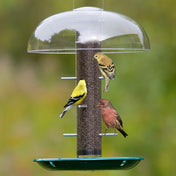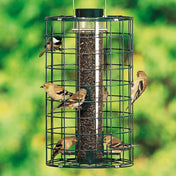Have you ever wondered why certain bird feeders seem to attract more feathered visitors than others?
The answer lies in the fascinating world of avian color vision. Birds perceive colors differently from humans, and understanding this can help you create a more inviting backyard for them.
Birds See a Broader Spectrum Than Humans
While humans are trichromatic—possessing three types of cone cells sensitive to red, green, and blue light—most birds are tetrachromatic. This means they have four types of cone cells, allowing them to see ultraviolet (UV) light in addition to the visible spectrum we perceive. This expanded vision enables birds to detect subtle differences in plumage, forage efficiently, and select mates based on UV-reflective patterns.
The Role of Oil Droplets in Avian Vision
Birds' cone cells contain oil droplets that act as filters, enhancing color discrimination by narrowing the range of wavelengths each cone type absorbs. These oil droplets fine-tune their color perception, allowing birds to distinguish between colors that might appear identical to the human eye.
Color Preferences in Bird Feeders
Research indicates that birds exhibit preferences for certain feeder colors:
-
Green and Silver: Studies have shown that many birds tend to favor green and silver feeders over brighter colors like red and yellow. These more natural tones can help feeders blend into the environment, making birds feel safer while feeding.
-
Red and Orange: Hummingbirds are particularly attracted to red and orange hues because many of the flowers they feed from are these vibrant colors. However, it's essential to avoid artificial red dyes in hummingbird feeders, as they can be harmful to their health. Some nectars are tinted naturally using ingredients like hibiscus flowers or carmine, but many bird experts recommend using clear nectar to ensure the safest option for hummingbirds.
Urban vs. Rural Bird Color Preferences
A study published in the Journal of Ornithology explored how urban and rural birds respond to feeder colors. It found that birds in both environments preferred green feeders over yellow ones. However, urban birds were more likely to approach yellow feeders than their rural counterparts, possibly due to increased exposure to diverse colors in urban settings.
Implications for Backyard Birding
Understanding birds' color vision can enhance your birdwatching experience:
-
Feeder Color: Choose feeder colors based on the species you wish to attract. Green or silver feeders are generally safe bets for a variety of birds, while red or orange feeders are ideal for attracting hummingbirds.
-
Avoid Artificial Dyes: Especially in hummingbird feeders, avoid using colored dyes, as they can be harmful.
- Natural Landscaping: Incorporate native plants with colors that appeal to local bird species, considering their unique color perception.





